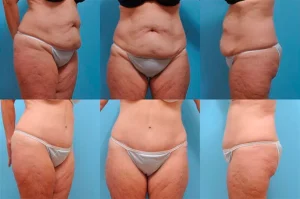If you have retracted or inverted nipples, you’re not alone.
Inverted nipples are a condition that affects ten to twenty percent of the general population, including both men and women. One or both of the nipples can have this condition, but most commonly, it’s bilateral, meaning both.
What are Inverted & Retracted Nipples?
Inverted nipples are when the entire nipple points inward. On the other hand, retracted nipples are when only part of the nipple is turned inward, such as the center of the areola. For this article, we’ll talk about them interchangeably to mean one or more nipples that don’t point outward.
While many instances of inverted/retracted nipples don’t pose a health risk, there can still be psychological or physiological damage.
So let’s get started as we cover the causes and symptoms of inverted nipples and treatment options for those who wish to change them.
What Are the Symptoms of Inverted Nipples?
The primary method of identifying inverted nipples is by simply observing their appearance.
If your nipples point inward or lay flat (flush to the rest of the areola), you have inverted nipples. You can always consult with a doctor for an official diagnosis.
Inverted nipples are graded on a scale of 1 to 3.
Grade 1 inverted nipples are those that respond to stimulation. For example, if you touched or pulled your nipple out with your fingers, it would stay that way for a few minutes before returning to its ordinarily inverted state.
Grade 2 inverted nipples are the most common. The main difference between grades 1 and 2 is that grade 2 inverted nipples return to laying flat or pointing inward immediately after letting go of them.
Grade 3 inverted nipples can’t be pulled out with your fingers. They never appear, respond to stimulation, or pop out.
If you were born with inverted nipples, then appearance is the main symptom you’ll notice.
But if your inverted nipples were acquired later in life, there might be a different underlying cause. You should speak with your doctor if you have inflammation, redness, discharge, lumps, or anything beyond aesthetics. These symptoms could be a sign of an infection or breast cancer.
What Are the Causes of Inverted Nipples?
As we just touched on, inverted nipples are either something you’re born with or the result of an underlying condition.
In most cases, both women and men are born with inverted nipples. They’re nothing to worry about. At most, they might cause a lack of confidence, posing just an aesthetic issue.
In rare cases, inverted nipples can indicate an underlying condition, such as breast cancer. If you notice other symptoms, such as those mentioned above, you must make an appointment with your doctor.
Other causes aren’t worrisome but may be bothersome.
For example, inflammation in the nipple area of women could shorten milk ducts and other tissues in the breast, causing an inversion. A biopsy or injury that results in scarring could also cause inverted nipples. Finally, some women might develop an inverted nipple while breastfeeding.
If your inverted nipples are not caused by something health- or life-threatening, you can move forward with a treatment plan, such as those listed below.
Treatment Options for Individuals Wanting Pronounced Nipples
This discussion leads to one crucial question: Can an inverted nipple be fixed? Does anyone know how to fix inverted nipples?
The answer is a resounding yes.
There are at least three solutions, two of which are non-surgical—depending on your grade of inversion. If you have a grade 1, you might want to avoid surgery for the moment, trying a non-surgical approach first. If you have a grade 2 or 3, there’s only one option—breast revision surgery.
Non-Surgical
The two non-surgical approaches include suction devices and nipple piercings.
Suction devices, sometimes called nipple correctors, are non-invasive tool that draws the nipple out. By putting pressure around the nipple, the nipple itself is forced out, remaining erect for longer than usual. This method is sometimes used by breastfeeding mothers with inverted nipples but won’t work for those with a higher grade of inversion.
Getting an inverted nipple piercing is another non-permanent solution for those with grade 1 nipples. The barbell helps nipples stay erect—but only while the bar is present. If you decide to take the piercing out, the nipple will return to its inverted state.
So, while these two options are non-surgical, they’re not permanent and not entirely non-invasive. While a suction device is, a piercing is not. If you have a grade 2 or 3 inversion or want a permanent solution, there’s only one option—breast revision surgery.
Surgical
Breast revision surgery is simple, effective, and permanent while preserving the milk ducts.
A plastic surgeon makes a small incision in the areola, allowing the fibers to stretch and spread. Since tightness is one of the reasons for inversion, this alone makes a big difference.
While the nipple is outward-facing, the surgeon places sutures under the skin, holding the pronounced nipple in place. During recovery, a protective device secures the nipple area to ensure the nipple doesn’t invert while healing.
While this procedure is considered “invasive,” it is minimally so. Because of this, the patient can expect to heal within a couple of weeks, depending on the person. The best part is that results are immediately noticeable—allowing you to reap the benefits immediately.
Take Advantage of Inverted Nipple Solutions
No one should spend their lifetime feeling self-conscious of their bodies. Whether young, old, male, or female—you deserve the confidence that comes with loving your breasts!
If you have retracted or inverted nipples and wish you didn’t, there are options for you.
However, the only permanent solution is breast revision surgery, which remains relatively simple yet effective.
Contact Plastic Surgery Group (PSG) in New Jersey to book a consultation today. We’ve provided the ultimate body transformation experience for more than 25 years. We look forward to helping you fall in love with yourself and your beautiful body.
Click here to reach out. Our plastic surgery center is in Montclair, NJ, in Morris County.




